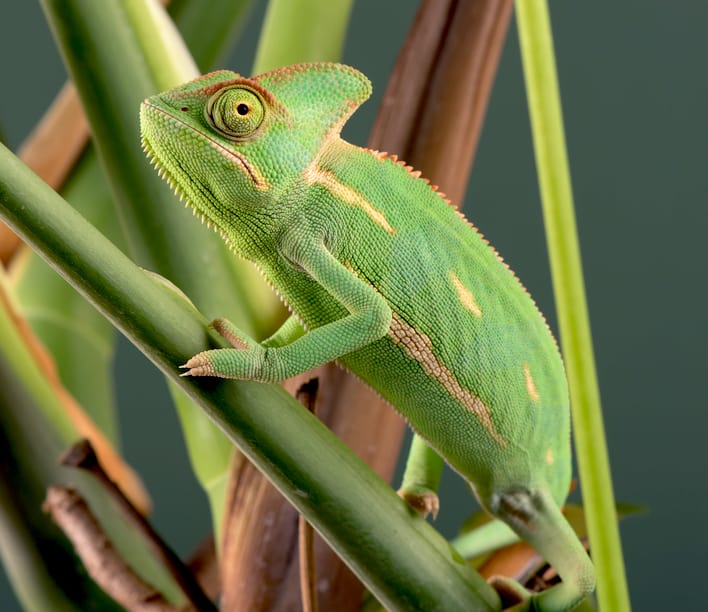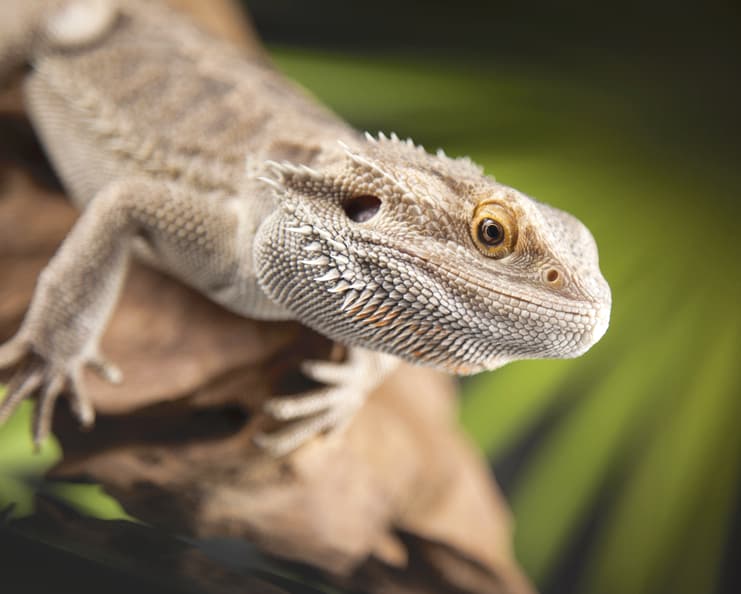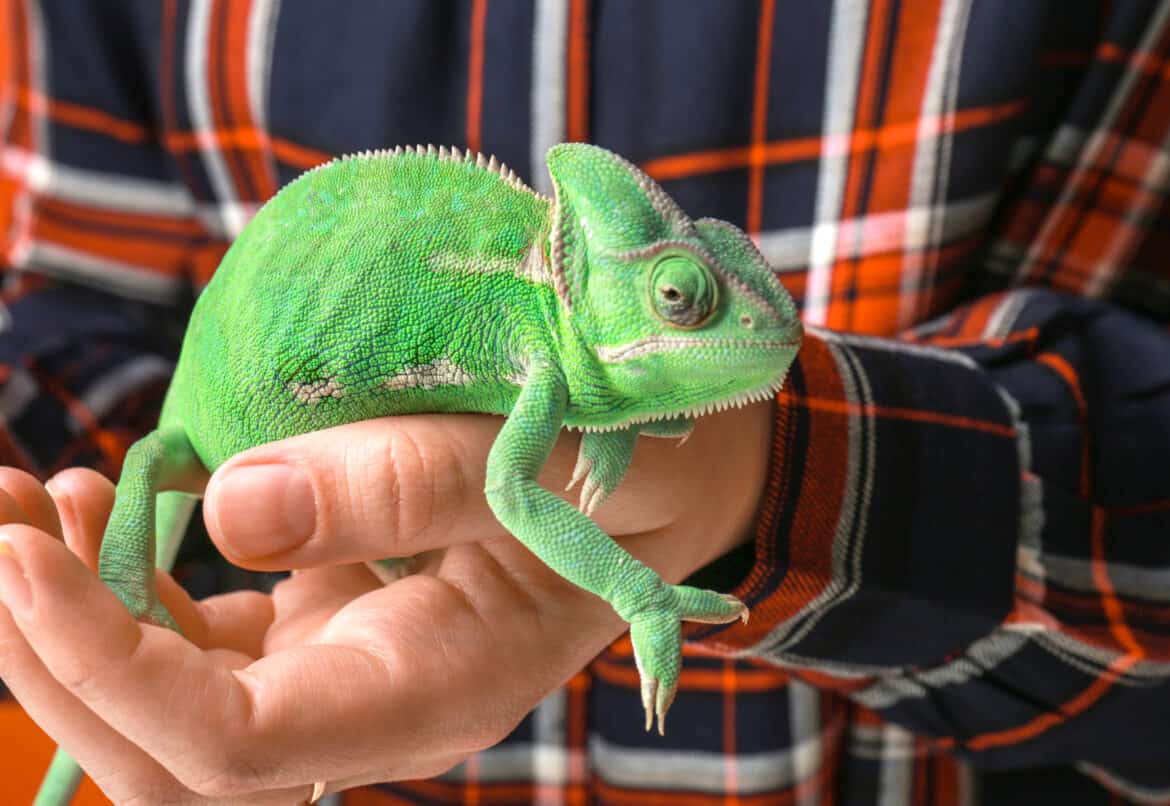Chameleons and bearded dragons are great options for reptile enthusiasts. Not only are they gorgeous and adorable, but they’re pretty easy to find as well. However, if you’re an aspiring keeper who can’t make up their mind about which reptile would suit them best, you’ve come to the right place!
How do you choose between a chameleon and a bearded dragon to keep as a pet? Chameleons and bearded dragons both have their own characteristics, diets, temperaments, and related costs to consider when deciding which one to get. Most of all, you should consider their environmental needs and whether you are up to the task of maintaining the right conditions for either.
What’s more, you have the option of going through this comprehensive comparison article to make your life easier. So, throw off all that uncertainty and get started on getting one step closer to owning the reptile of your dreams.
What You Should Know About Chameleons

I’ve divided the chameleon (and beardies) section into three categories so you can keep up with the comparison with ease.
And with that out of the way, let’s get this chameleon vs. bearded dragon showdown on the road!
So, the first thing you need to know about chameleons is that they’re not beginner reptiles. Their care requirements are pretty specific, and these guys get stressed out very quickly.
Don’t let those scales and spikes fool you; chameleons are pretty fragile creatures that should be handled gently and kept responsibly.
However, chameleons are still very popular as pets because, well, just look at them! Not to mention, they can move their eyes independently and have a projectile tongue. Pretty darn cool, if you ask me!
Before we dive into the details, you should know that there are more than one species of chameleon that are kept as pets.
The most common ones are veiled chameleons, panther chameleons (the super colorful ones that look a bit like sad clowns), carpet chameleons, and Jackson’s chameleons. Each species may vary a bit in terms of how they are kept, so this is just a rough guide for what you can expect from owning a chameleon of any sort.
With that said, if you want to know the basics of their general habitat, behavior, diet, and costs, then stick with us.
Habitat
As tropical reptiles, chameleons thrive in hot, humid environments. It is incredibly important to create an enclosure that can maintain the right balance of humidity and heat using a mister and a heat lamp.
If you do not have a mister, you can mist the enclosure manually 4-5 times a day instead, but it’s harder to remember this way, and it takes more time and effort out of your day.
You should get a thermometer and hygrometer you can stick on the inside of your tank so that you can keep track of the temperature and humidity levels and adjust your setup as necessary. A healthy environment for a chameleon sits between 65-80% humidity. The temperature should be a balmy 75-80°F.
Your chameleon should have plenty of branches and leafy plants to hold onto, even if they’re all artificial. In the wild, they spend their time in the trees, blending into the leaves and holding onto branches with their split feet.
If there is not enough foliage for it to hide and climb around, your chameleon will feel exposed and become stressed.
Temperament
First of all, we need to bust a myth. Most people believe that chameleons change color to camouflage themselves into their surroundings. In reality, chameleons change color according to their mood. Yes, that’s right, if you can get one to hang onto your finger, you’ve got a living mood ring on your hands.
This is a form of communication and you can even learn to read the signs your chameleon is showing you to tell if it is healthy and happy. For example, veiled chameleons will curl up and their scales will turn darker when they are scared.
Panther chameleons are a bit more complicated to read from their colors because they tend to be more colorful at all times and change more often.
For the most part, a chameleon’s true neutral color is green. Patterns of spots and stripes combined with hissing and leg-raising or brown-beige colors can be signs your chameleon is being aggressive or is too cold, respectively.
Chameleons are solitary creatures, so if you’re looking for a reptile that likes to be touched, held, and played with, look elsewhere. Apart from that, while chameleons aren’t very aggressive, they can act out if they feel threatened. In a nutshell, a chameleon likes to be left to its own devices.
However, note that these behaviors may vary based on the type of chameleon you pick. For instance, veiled chameleons are quite territorial and will act out if you get too close to their territory.
On the other hand, Jackson chameleons, despite their wicked-looking set of three horns, are one of the most docile chameleons you’re bound to run into, and they’re easy to handle. But that doesn’t mean they like being handled or touched too much.
Finally, panther chameleons are a little calmer than veiled chameleons, but they’re still pretty feisty and like being left alone to get on with their lives.
Diet
Chameleons, like all reptiles, have a very specific diet that can consist of live insects or other ingredients that are hard to come by. If you decide to get a chameleon, make sure you’ll have access to these foods and that you’re not squeamish about handling them.
They are also omnivorous, and many owners make the mistake of only offering them insects. However, there are some important nutrients chameleons need that they can only get from vegetables (like this mix which we’d highly recommend!). If your chameleon refuses to eat veggies, you may want to supplement their diet with reptile-specific powders.
In fact, you should be feeding them D3 and calcium powder a few times a week.
A pet chameleon’s diet should consist of the following:
- A water mister or dripper (chameleons drink droplets of water)
- Fresh or live insects such as mealworms, roaches, and crickets
- Fresh leafy green veggies like kale, romaine lettuce, collard greens, or dandelion greens
- Calcium and D3 supplement powder (a few times a week)
When it comes to feeding, young chameleons should be fed around 15 small insects every day, whereas adult chameleons (8-10 months) can be fed around 6 larger insects every other day.
We can’t stress enough that chameleons also need calcium supplements and multivitamin supplements to stay healthy. You can take care of their water supply by misting the plants in their terrarium at least four times daily, or you can use a mister or a dripper.
Related Costs
Buying a chameleon can cost you anywhere from $30 to $600, depending on the chameleon’s species, age, gender, and of course, where you buy it from. However, always remember to buy a chameleon from a reputable pet store or breeder to ensure your pet is well-treated and has no health issues or mites.
Approximate Chameleon Setup Costs:
- Tank/enclosure – $50-300
- Plants (real or artificial) and bedding – $60 -150
- Food – $10-30/month
- Water setup – $30-50
- Digital thermometer and hygrometer – $8 to $50
- Lighting Arrangement – $40-120
Of course, these prices vary wildly depending on where you source your equipment, how high-quality your setup is, and whether you’re able to make some of your own pieces for cheaper.
What You Should Know About Bearded Dragons

Bearded dragons are available in countless varieties and colors, so you’ll have plenty of choices in that regard.
But, here’s what makes beardies great; they love to be handled, and they require minimal effort to take care of.
That’s why bearded dragons can make great beginner reptiles for the responsible owner.
Now, that’s not to say that you can just throw your beardie in a glass tank, feed it every once in awhile, and call it good.
Bearded dragons also have their specific requirements; they’re just easier to maintain than those of a chameleon.
Habitat
Before we go into anything else, we have to stress the most important part to keeping bearded dragons happy and healthy.
Bearded dragons need a UVB light and calcium and D3 supplements, or they are especially susceptible to metabolic bone disease. MBD impairs bone growth because the calcium deficient body pulls it from its bones instead, resulting in underdeveloped and deformed bones.
For bearded dragons, this disease is most evident in their back legs. If they are twisted or barely functional, your beardie may have MBD and should visit a vet.
To sum up, a regular heat lamp just will not suffice for these natural desert dwellers, and neither will a supplement-free diet.
What makes these desert lizards easier to care for than chameleons is that they do not need a mister or any extra humidity, unless you live somewhere incredibly dry that reaches humidity levels below 20%. Just keep a watchful eye on your hyrgometer and make sure it is between 20-40%.
The heat in your bearded dragon’s enclosure should remain around 75-85°F and between 85-100°F in the spot where they sunbathe. This difference in temperatures for different areas is important for your reptile’s ability to regulate their temperature by retreating to a cooler place or seeking a hot spot.
Other than these important requirements, your beardie should have a sandy or flat bedding, a shallow water bowl, and rocks or plastic shelves so that it can hide, climb, and sunbathe.
Temperament
Beardies can flare the skin near their throat area when they’re feeling scared or territorial. And, based on their spiky appearance, you’d think they have a mean streak. But bearded dragons make excellent pets because of their docile nature.
Additionally, once a beardie has adjusted to your home and surroundings, they’re entertaining to observe, safe around kids, and even enjoy being picked up gently and handled with care.
Plus, bearded dragons are diurnal (they’re active during the day and rest at night), so they sync with your lifestyle without significant upsets. Beardies can even form a bond with their keeper once they’re used to your scent, which means you can develop a lasting attachment with your pet. Who says reptiles don’t feel?
Diet
Bearded dragons are pretty flexible when it comes to diet and can eat a wide variety of things, along with the right supplements to boost their health and prevent MBD.
Here are some of the things beardies can consume:
- Insects and live feed like kingworms, waxworms, crickets, etc.
- Leafy greens like kale, dandelion greens, arugula, etc.
- Diced vegetables and fruits such as peas, bok-choy, melon, peaches, etc.
Keep in mind that anything you feed your beardie needs to cut to size to fit its mouth. Also, juvenile bearded dragons need a diet consisting of insects (50%) and plants, veggies, and fruits (50%).
On the other hand, adult beardies need a diet that includes more vegetation and around 30% of insect feed because they’re prone to obesity.
Finally, beardies in captivity also require calcium and vitamin D supplements. They also need multivitamins.
Related Costs
Because bearded dragons are available in such a wide variety, buying one can range from $40 to $900 depending on the type, age, and whether you buy your pet from a store or a breeder.
Suffice it to say, the more exotic the type is, the more expensive the beardie will be. Apart from the cost of buying a bearded dragon, here are the expenses concerning housing your pet.
Approximate Bearded Dragon Setup Costs:
- Glass tank/enclosure – $50 to $300
- UVB lighting – $30 to $50
- Heating (ceramic) – $15 to $30
- Dishes (food & bath) – $10 to $40
- Mat or substrate – $5 to $40
- Plants, rocks, hides – $15 to $40
- Digital thermometer and hygrometer- $8-$50
As we mentioned previously, these costs are just a rough approximation and will vary based on a list of factors.
Which Is the Better Pet?
Trying to compare chameleons and bearded dragons is like comparing apples and oranges – pointless.
Both types of reptiles have their pros and cons. Chameleons are tropical and beautiful to look at with their ability to change colors. Beardies can be found in a multitude of colors, from pure white to blood red and are the most docile reptiles you can own.
As a future reptile owner, your job will become a lot easier if you pick the reptile that will best fit in with your lifestyle. If you’re looking for a pet reptile that’s easy to look after, likes being picked up, and is more docile, then opt for a bearded dragon.
In contrast, if you’re not a beginner regarding reptile pets and are confident enough to take care of a pet that requires a little extra upkeep, doesn’t like being handled, and is a bit picky or aggressive at times, then buying a chameleon shouldn’t be a problem for you.
The crucial bit is that you’re 100% committed to taking care of your pet the whole way.
Related Questions
Is It Better To Get A Female Or Male Chameleon?
If you’re trying to decide between picking a male or female chameleon, the truth is that both sexes have their pros and cons, but most owners tend to prefer males.
A female chameleon is less territorial, and therefore less aggressive than male chameleons. But, female chameleons require more TLC because once they hit puberty, they start laying eggs even when there’s no male chameleon around to mate with.
It’s been said that the process of laying eggs can be stressful for female chameleons, so much so that it can even shorten their lifespan.
On the flip side, male chameleons are bigger in size, have brighter colors, and are easier to take care of since they don’t have to go through the process of laying eggs. They also tend to form cool ridges, spikes, or horns when they’re older that females don’t have the ability to develop.
Is It Better To Get A Female Or Male Bearded Dragon?
While there’s not much of a difference between how male or female bearded dragons look, there are a few distinctions you should know about.
Male beardies are larger in size and have more outgoing personalities. Conversely, male bearded dragons tend to get aggressive and a bit moody during the breeding season.
Female bearded dragons are calmer overall and during the breeding season. However, they lay eggs upon reaching sexual maturity, even without a Mr. Beardie.
During this time, you have to be more careful about a female beardie’s diet and care. And, you have to provide your pet with a covered enclosure (or hiding spot) for her to lay her eggs.
Can A Chameleon Live With A Bearded Dragon?
Bearded Dragons and chameleons are too different housing and temperament-wise to ever live in one enclosure or tank. Their humidity requirements are completely opposite of each other.
Even though beardies are quite docile, they’re very territorial about their space, and chameleons are solitary by nature, so placing them in a tank with one another is just a recipe for disaster.
Owners report that both reptiles can get stressed out if their tanks are even placed next to each other or at a seeing distance. That’s why, if you’re planning on buying both species, it’s best to house them in different rooms.
Up Next: Do Leopard Geckos Make Noise?
